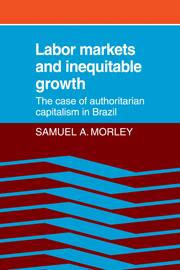Book contents
- Frontmatter
- Contents
- List of tables and figures
- Preface
- Part I Growth, employment creation, and inequality in Brazil
- Part II The effect of supply and demand on labor markets during rapid economic growth
- 6 Migration and the modernization of the agricultural labor force
- 7 The absorption of migrants into the urban economy
- 8 Trends and theories of the wage differential during economic growth
- 9 The market for skilled labor
- 10 Agriculture, wage policy, and the wages of unskilled labor
- 11 Additional perspectives on inequitable growth in Brazil
- 12 Conclusions
- Data appendix
- Bibliography
- Index
9 - The market for skilled labor
Published online by Cambridge University Press: 07 October 2011
- Frontmatter
- Contents
- List of tables and figures
- Preface
- Part I Growth, employment creation, and inequality in Brazil
- Part II The effect of supply and demand on labor markets during rapid economic growth
- 6 Migration and the modernization of the agricultural labor force
- 7 The absorption of migrants into the urban economy
- 8 Trends and theories of the wage differential during economic growth
- 9 The market for skilled labor
- 10 Agriculture, wage policy, and the wages of unskilled labor
- 11 Additional perspectives on inequitable growth in Brazil
- 12 Conclusions
- Data appendix
- Bibliography
- Index
Summary
Only recently have development economists begun to appreciate the importance of the structure of demand on labor absorption, wage differentials, and the distribution of income. In a dual economy with surplus labor, highly capital-intensive growth can be expected to put a premium on skills and therefore to increase the urban skill differential. In a complementary fashion, the less the demand for unskilled labor, the longer the time to the turning point and the less positive the effect of growth on wages and incomes at the bottom of the income pyramid.
Economic growth in Brazil during the postwar period has been highly skill intensive. It has favored the well educated in the sense that the demand for administrators, teachers, and technicians has grown far faster than the demand for either agricultural labor or urban blue-collar labor. At the same time, there has been a very rapid increase in the supply of educated labor, particularly at the secondary and university level. In this chapter we examine the dimensions of skill-intensive growth and the reasons for rising skill differentials by looking at the demand and supply of skilled labor. In the next chapter we shall make the same analysis for unskilled labor.
Occupational structure and skill-intensive growth
As is the case with all developing countries, there has been a shift in Brazil's labor force out of blue-collar occupations in the postwar period. Manual employment grew 2.4% per year between 1950 and 1970. White-collar labor grew 4.8%.There appears to have been a pronounced speed up in this process in the 1960s relative to the 1950s (see Table 9.1).
- Type
- Chapter
- Information
- Labor Markets and Inequitable GrowthThe Case of Authoritarian Capitalism in Brazil, pp. 200 - 232Publisher: Cambridge University PressPrint publication year: 1983



